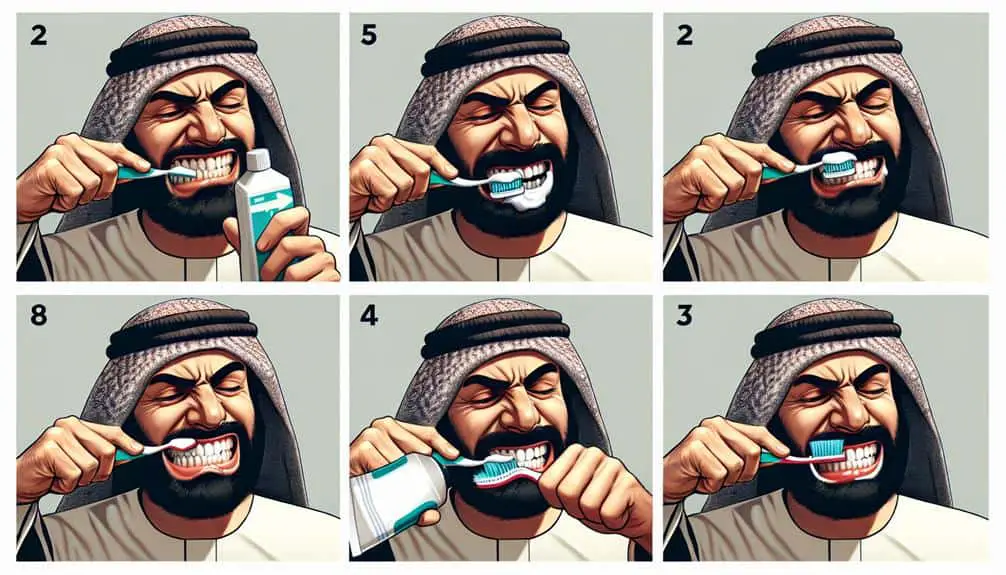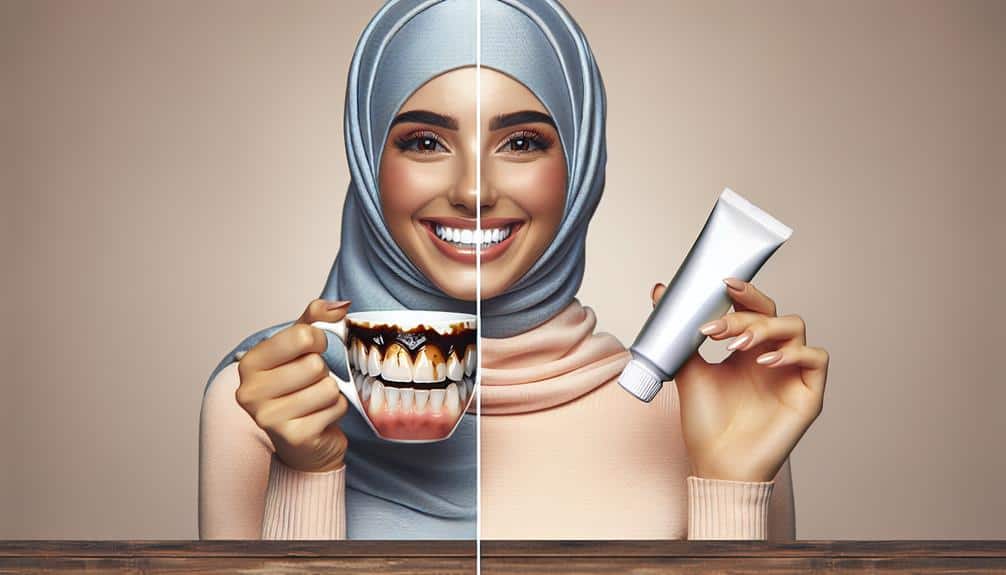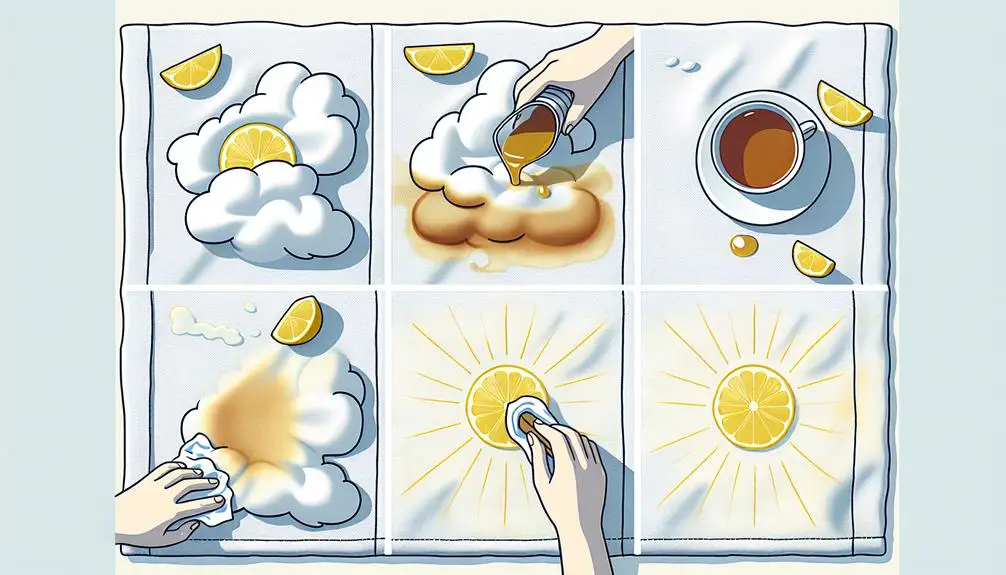To eliminate tea stains from your teeth, begin with whitening toothpaste containing hydrogen peroxide or baking soda. Brush at a 45-degree angle with gentle circular motions for 2 minutes using a soft-bristled toothbrush. For home remedies, consider baking soda with water or activated charcoal. Professional options like in-office bleaching or custom trays are available for immediate or gradual results. Maintain a stain-free smile by scheduling dental cleanings and tips like using a straw when drinking tea. Explore the full step-by-step guide for thorough tea stain removal techniques.
Key Points
- Use whitening toothpaste with mild abrasives and fluoride.
- Brush teeth gently with fluoride toothpaste twice daily.
- Consider natural remedies like baking soda or activated charcoal.
- Explore professional whitening options for immediate results.
- Maintain oral hygiene, opt for lighter teas, and rinse after consumption.
Choosing the Right Toothpaste
When selecting a toothpaste for removing tea stains from your teeth, opt for one that contains whitening agents like hydrogen peroxide or baking soda. These ingredients are effective in breaking down the stains and restoring your teeth's natural whiteness.
Additionally, look for toothpaste that includes fluoride benefits. Fluoride helps strengthen the enamel, making it more resistant to future stains and decay.
In terms of abrasive ingredients, a toothpaste with mild abrasives can aid in removing surface stains without damaging the enamel. Ingredients like hydrated silica or calcium carbonate are gentle enough to scrub away stains but not too harsh on your teeth. Be cautious of toothpaste with overly abrasive components, as they can wear down the enamel over time, leading to sensitivity and other dental issues.
Choosing a toothpaste with the right balance of whitening agents, fluoride benefits, and mild abrasives won't only help in removing tea stains but also in maintaining your oral health in the long run.
Brushing Technique for Tea Stains
For effectively removing tea stains from your teeth, mastering the proper brushing technique is essential to guarantee thorough stain removal and maintain oral health. To begin, make sure you're using a soft-bristled toothbrush that's gentle on your enamel and gums. Apply a pea-sized amount of fluoride toothpaste to your brush. Hold the toothbrush at a 45-degree angle to your gums, using gentle circular motions to clean the front, back, and chewing surfaces of your teeth. Pay extra attention to areas where tea stains tend to accumulate, such as the front teeth. Brush for a full two minutes to ensure all surfaces are properly cleaned.
Proper technique involves not only how you brush but also how often you brush. Brush your teeth at least twice a day, particularly after consuming tea or other staining beverages. Additionally, consider incorporating flossing into your routine to remove plaque and prevent staining between teeth. By mastering the proper brushing technique and adopting good oral hygiene habits, you can effectively remove tea stains and prevent their recurrence.
Using Natural Remedies at Home
To naturally address tea stains on your teeth, explore effective home remedies that can help brighten your smile and maintain oral hygiene. DIY whitening solutions offer an accessible and inexpensive way to combat discoloration caused by tea consumption. Baking soda, a common household item, can be mixed with water to form a paste that gently scrubs away surface stains. Remember to use this mixture sparingly to avoid damaging your enamel.
Additionally, herbal remedies like activated charcoal can act as a vital teeth whitener. Its porous texture can attract and remove stains from the teeth when used cautiously. Coconut oil pulling is another popular method that involves swishing coconut oil around in your mouth to reduce bacteria and plaque buildup, which can contribute to staining.
While these natural remedies can be effective, it's important to use them in moderation and consult with a dental professional if you have any concerns. Consistent oral hygiene practices, such as regular brushing and flossing, are important for maintaining a healthy smile alongside these home remedies.
Professional Whitening Options Available
Consider professional whitening options available at dental offices to effectively remove stubborn tea stains from your teeth and achieve a brighter, whiter smile. Cosmetic dentistry offers various dental procedures to help you achieve the desired results. One popular method is in-office bleaching, where a strong whitening agent is applied to your teeth. This procedure can lighten your teeth several shades in just one session, offering immediate results.
Another option is custom-fitted trays filled with a whitening solution that you can use at home. This method allows for a more gradual whitening process but can still provide significant improvements over time. Additionally, some dental offices offer laser teeth whitening, which accelerates the bleaching process for quicker results.
Before undergoing any professional whitening treatment, it's essential to consult with a dentist to determine the best option for your specific needs. Dental professionals can assess your teeth's condition and recommend the most suitable cosmetic dentistry procedure to effectively remove tea stains and brighten your smile.
Maintaining a Tea-Stain-Free Smile
To maintain a tea-stain-free smile, regular dental cleanings and proper oral hygiene practices are essential. Tea alternatives, such as herbal teas or lighter-colored teas, can also help prevent staining. Preventive measures like using a straw when drinking tea to minimize contact with your teeth, rinsing your mouth with water after consuming tea, and brushing your teeth at least twice a day with a fluoride toothpaste are critical in maintaining a bright smile.
In addition to these steps, incorporating regular dental check-ups into your routine is important for the early detection and removal of any potential tea stains. Your dentist can provide professional cleanings and offer personalized advice on how to keep your teeth free from tea stains.
Frequently Asked Questions
Can Tea Stains on Teeth Be Prevented in the First Place?
To prevent tea stains on teeth, consider switching to tea alternatives or using a straw. Maintain good oral hygiene with regular brushing and flossing. Eat a balanced diet and limit tea consumption. These steps can help prevent staining.
How Long Does It Typically Take to See Results From Using Natural Remedies for Tea Stains?
Like planting a seed and waiting for a sprout, using natural remedies for tea stains requires patience. Results vary, but typically, noticeable improvements may be seen within a few weeks of consistent use.
Are There Any Long-Term Side Effects of Professional Whitening Options for Tea Stains?
Considering professional whitening options for tea stains, it's important to weigh the cost and risks involved. Under professional supervision, long-term effects like tooth sensitivity or gum irritation may occur. Consult your dentist for guidance.
Can Drinking Tea Through a Straw Help Prevent Tea Stains on Teeth?
Drinking tea through a straw can be a smart move in preventing tea stains on your teeth. This simple technique can minimize direct contact between the tea and your enamel, contributing to the effectiveness of stain prevention.
Are There Any Specific Foods or Drinks to Avoid in Order to Maintain a Tea-Stain-Free Smile?
To maintain a tea-stain-free smile, focus on stain prevention by avoiding foods and drinks that can discolor teeth. Dark liquids like coffee and red wine, acidic beverages such as soda, and pigmented foods like berries can impact tooth color over time.



